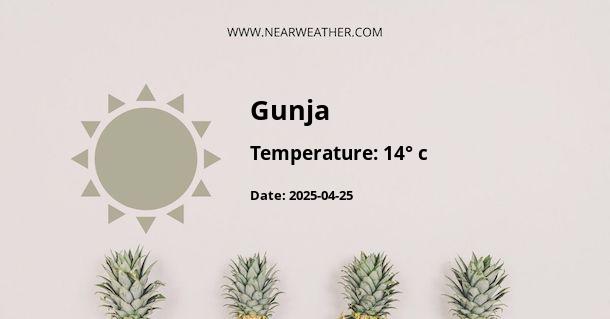Understanding the Climate and Weather of Gunja, Croatia
Gunja, a charming town in the Vukovar-Srijem County of Croatia, experiences a climate marked by both continental and Mediterranean influences. Its geographic position at the confluence of the Sava and Vuka Rivers not only enriches the natural beauty but also contributes to the distinct climate patterns that characterize the locality. Here, we'll delve into a detailed overview of Gunja's climate, exploring its seasonal variations and weather conditions throughout the year.
Geographical Influence on Gunja's Climate
The location of Gunja within the interior of Croatia, away from the Adriatic Sea, predisposes it to a predominantly continental climate. This brings about variations with warm to hot summers and cold winters. Nevertheless, Mediterranean subtropical influences are also felt due to the southerly flows that bring in warmer and more humid air masses, especially during the transitional periods between seasons.
Seasonal Overview of Gunja's Climate
- Spring (March - May): As Gunja transitions from winter to summer, it experiences springtime with moderate temperatures and increasing daylight. An increase in precipitation is also observed during this season, which brings about the lush greenery the region is known for.
- Summer (June - August): The warmest period in Gunja, summers are characterized by high temperatures and humidity. Long, sunny days are prevalent, making this the ideal time for outdoor activities and agriculture.
- Autumn (September - November): Autumn witnesses a gradual decline in temperatures, with cooler weather setting in towards the end of the season. Rainfall is quite common in autumn, contributing to the area's rich agriculture.
- Winter (December - February): Gunja's winters are marked by cold temperatures that can dip below freezing, occasionally bringing snowfall. The proximity to the rivers can increase the area's humidity, leading to foggy conditions.
Temperature and Precipitation Patterns
| Month | Average High (°C) | Average Low (°C) | Precipitation (mm) |
|---|---|---|---|
| January | 3.5 | -3.0 | 35 |
| February | 6.0 | -1.5 | 30 |
| March | 11.0 | 1.5 | 40 |
| April | 16.0 | 5.5 | 50 |
| May | 21.5 | 10.0 | 60 |
| June | 24.5 | 13.0 | 80 |
| July | 26.5 | 14.5 | 70 |
| August | 26.0 | 14.0 | 60 |
| September | 21.0 | 10.5 | 50 |
| October | 15.5 | 5.5 | 45 |
| November | 9.0 | 1.5 | 50 |
| December | 4.0 | -2.0 | 50 |
These averages paint a comprehensive picture of the typical conditions one might expect in Gunja. However, it's important to note that these are subject to variation as a result of broader climatic changes, including those driven by global climate change.
Extreme Weather and Climate Events
"Gunja, like many parts of Croatia, isn't immune to extreme weather such as intense heat waves, severe thunderstorms, and freezing spells in winter," notes a regional climatologist.
Weather Forecasting and Its Importance for Gunja
Reliable weather forecasts are vital for Gunja's residents, particularly those involved in agriculture and other outdoor-dependent occupations. Precision in forecasting allows for better preparation against potential weather hazards and for optimizing farming practices to suit upcoming weather conditions.
Average Sunshine and Daylight Hours
- Summer: Approximately 14-15 hours of daylight with up to 10 hours of sunshine per day.
- Winter: Roughly 9 hours of daylight with about 2 to 3 hours of sunshine per day.
Year-Round Weather Considerations for Travelers and Residents
For those planning to visit or relocate to Gunja, understanding the local weather patterns is key. Summers are ideal for sightseeing and exploring the natural landscapes, while winters call for indoor activities and experiencing the festive atmosphere. The shoulder seasons, spring and autumn, offer a mix of mild weather, with the additional benefit of fewer tourists.
Environmental Impact and Climate Change Considerations
Gunja's climate is not isolated from the impacts of climate change. Increasing temperatures, changes in precipitation patterns, and the frequency of extreme weather events are concerns that could affect the region's agriculture, biodiversity, and quality of life.
Adaptation and Resilience Strategies
Local authorities in Gunja, alongside Croatian national agencies, are working on strategies to mitigate climate change impacts. This includes improving infrastructure to withstand extreme weather, adopting sustainable agricultural practices, and conserving natural water resources.
In summary, Gunja, with its continental climate nuanced by Mediterranean influences, experiences a wide variety of weather patterns throughout the year. From warm, pleasant summers to brisk, chilly winters, the town's climate dictates much of everyday life and activities. Visitors and residents alike must be mindful of the seasonal changes and extreme weather events, along with their broader implications in the context of a changing climate. Accurate weather forecasting and adherence to environmental guidelines remain essential for the overall sustainability and heightened experience of the unique climate in Gunja, Croatia.
A - Gunja's Latitude is 44.880001 & Longitude is 18.853331.
A - Weather in Gunja is 14° today.
A - Climate Conditions in Gunja shows overcast clouds today.
A - Humidity in Gunja is 89% today.
A - Wind speed in Gunja is 8.86 km/h, flowing at 294° wind direction. today.
